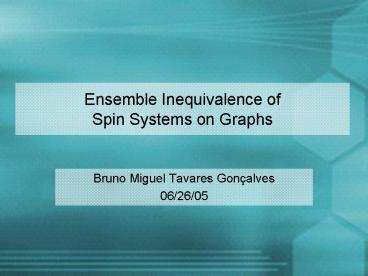Ensemble Inequivalence of Spin Systems on Graphs - PowerPoint PPT Presentation
1 / 30
Title:
Ensemble Inequivalence of Spin Systems on Graphs
Description:
Direct enumeration of system configurations (density of states for a given energy) ... Astrophysics (self-gravitating systems) Spin systems. 2D Vortices ... – PowerPoint PPT presentation
Number of Views:29
Avg rating:3.0/5.0
Title: Ensemble Inequivalence of Spin Systems on Graphs
1
Ensemble Inequivalence of Spin Systems on Graphs
- Bruno Miguel Tavares Gonçalves
- 06/26/05
2
Contents
- Statistical Ensembles
- Microcanonical Ensemble
- Canonical Ensemble
- Ensemble Inequivalence
- Models of Spin Systems
- Graph structures
- K-regular graphs
- Erdös-Renyi
- Small-World Networks
- Different Approaches
3
Microcanonical Ensemble
- Fixed Energy
- Direct enumeration of system configurations
(density of states for a given energy) - Entropy can be written as
- Value of the entropy can be obtained my
maximizing over the magnetization - Remaining thermodynamical quantities of interest
can be determined from the Entropy
4
Canonical Ensemble
- Contact with a head bath at a given temperature
is assumed - Energy varies around a mean value U(T) which is a
function of the temperature - Partition function is
- Free Energy
- All other quantities can be calculated from the
Helmoltz Free Energy
5
Ensemble Inequivalence
- Microcanonical ensemble exhibits energy ranges
with negative specific heat - Non-concave entropy curve
- Present in non-additive systems
- Predicted by theory in
- Astrophysics (self-gravitating systems)
- Spin systems
- 2D Vortices
- Small systems where surface energy is comparable
to bulk energy - Observed experimentally in
- Nuclear physics
- Atomic clusters
6
Spin Systems
- Ising spins have only two possible directions, UP
or DOWN. - Other types of spins (BEG, Potts, etc) are
allowed more orientations - Hamiltonian usually contains spin-spin
interactions and interaction with an external
field - System dynamics is due only to spin flips
7
K-Regular Graphs
- Start with N nodes
- Add edges in such a way that in the end each node
has the same number of connections as as all
other nodes - Total number of edges is
- Self-Loops and double edges are not allowed
(unphysical)
8
K-Regular Graphs
9
Erdös-Renyi Graphs
- Start with N individual nodes
- Create edges between all pairs of nodes with
probability p - Connectivity distribution
- K-Regular graph can be considered a mean field
version
10
Watts-Strogatz
- At t0 we have a ring where each node is
connected to K neighbors. - - At each step, a connection is modified with
probability p.
11
WS-Small World
12
Different Approaches
- Classical results
- Enumeration of configurations in the
Microcanonical ensemble - Calculation of the partition function and the
free energy for the Canonical ensemble - Flat Histogram computer simulation to determine
the density of states for all energy values - Cavity method
13
Ising Model
- Microcanonical Ensemble
14
MicrocanonicalEntropy as a function of Energy
15
MicrocanonicalEntropy as a function of
magnetization
E-0.9
E-1.0
E-1.1
16
Microcanonical Entropy as a function of
magnetization at h0
E-0.5,-1
17
Microcanonical?(E) at h1
18
Ising Model
- Canonical Ensemble
19
CanonicalEnergy as a function of ?
20
The End
21
The End
22
Wang-Landau Dynamics
- Perform a random walk in phase space by flipping
randomly selected spins - Accept a given spin flip with probability given
by - Every time an energy level is visited modify the
density of states - When the histogram is flat reduce the
modification factor - PRE 64,056101
23
Simulation
24
Simulation
25
Input File
K-Reg Ising model
input file
System definition
Number of spins
in the system N 1000 System connectivity "k" K
4 External field in units of the bond strength
(H/J) H 1.0
Simulation parameters
All energies are assumed to be per spin
and in units of the bond strength (E/NJ)
Minimum energy Emin -1 Maximum energy Emax 1
Size of Energy steps DeltaE 0.002 Density of
states ratio f0 2.78 Minimal value of f. Final
results will be precise to O(ln(ftol)) ftol
1.0000002 Flatness level flat 0.1 Type of
decrease in f n (gt1) -gt f_i1(f_i)(1/n)
others can be added later type 2.0
End input file
26
Allowed magnetizations
27
Phase Separation
- Non-concave entropy curve
- Separate system in two phases with energy e1 and
energy e2 - Entropy is now given by straight line
- Non-applicable to non-additive systems
28
Cavity Method
J. Stat. Phys 111 (2003) 1
29
Cavity Method
J. Stat. Phys 111 (2003) 1
30
Scale-Free Networks
- Connectivity distribution obeys a power-law
- Usually include some form of preferential
attachment during the growth process - No characteristic value of the degree
- All values of connectivity are possible,
limited only by finite size effects














![Top 5 Tennis Strings for Spin 2021 [Reviewed] PowerPoint PPT Presentation](https://s3.amazonaws.com/images.powershow.com/9683536.th0.jpg?_=202111150212)
















